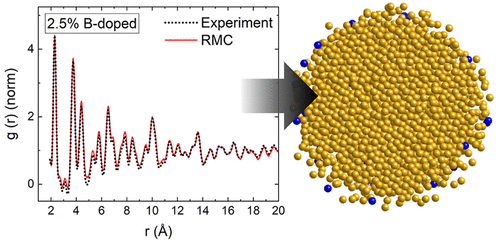当前位置:
X-MOL 学术
›
Nano Lett.
›
论文详情
Our official English website, www.x-mol.net, welcomes your feedback! (Note: you will need to create a separate account there.)
Probing Dopant Locations in Silicon Nanocrystals via High Energy X-ray Diffraction and Reverse Monte Carlo Simulation.
Nano Letters ( IF 10.8 ) Pub Date : 2020-01-02 , DOI: 10.1021/acs.nanolett.9b03025 Katharine I Hunter 1 , Nicholas Bedford 2 , Katelyn Schramke 1 , Uwe R Kortshagen 1
Nano Letters ( IF 10.8 ) Pub Date : 2020-01-02 , DOI: 10.1021/acs.nanolett.9b03025 Katharine I Hunter 1 , Nicholas Bedford 2 , Katelyn Schramke 1 , Uwe R Kortshagen 1
Affiliation

|
Understanding the locations of dopant atoms in ensembles of nanocrystals is crucial to controlling the dopants' function. While electron microscopy and atom probe tomography methods allow investigation of dopant location for small numbers of nanocrystals, assessing large ensembles has remained a challenge. Here, we are using high energy X-ray diffraction (HE-XRD) and structure reconstruction via reverse Monte Carlo simulation to characterize nanocrystal structure and dopant locations in ensembles of highly boron and phosphorus doped silicon nanocrystals (Si NCs). These plasma-synthesized NCs are a particularly intriguing test system for such an investigation, as elemental analysis suggests that Si NCs can be "hyperdoped" beyond the thermodynamic solubility limit in bulk silicon. Yet, free carrier densities derived from local surface plasmon resonances suggest that only a fraction of dopants are active. We demonstrate that the structural characteristics garnered from HE-XRD and structure reconstruction elucidate dopant location and doping efficacy for doped Si NCs from an atomic-scale perspective.
中文翻译:

通过高能X射线衍射和反向蒙特卡洛模拟在硅纳米晶体中探测掺杂剂的位置。
了解纳米晶团中掺杂原子的位置对于控制掺杂剂的功能至关重要。尽管电子显微镜和原子探针层析成像方法可以研究少量纳米晶体的掺杂物位置,但评估大型整体仍然是一项挑战。在这里,我们使用高能X射线衍射(HE-XRD)并通过反向蒙特卡洛模拟进行结构重建,以表征高硼和磷掺杂的硅纳米晶体(Si NCs)集成体中的纳米晶体结构和掺杂剂位置。这些等离子体合成的NCs对于此类研究是一个特别吸引人的测试系统,因为元素分析表明,Si NCs可以被“超掺杂”,超出了块状硅中热力学溶解度的极限。然而,由局部表面等离振子共振产生的自由载流子密度表明只有一部分掺杂剂是有活性的。我们证明了从HE-XRD获得的结构特征和结构重建从原子尺度的角度阐明了掺杂Si NCs的掺杂剂位置和掺杂功效。
更新日期:2020-01-04
中文翻译:

通过高能X射线衍射和反向蒙特卡洛模拟在硅纳米晶体中探测掺杂剂的位置。
了解纳米晶团中掺杂原子的位置对于控制掺杂剂的功能至关重要。尽管电子显微镜和原子探针层析成像方法可以研究少量纳米晶体的掺杂物位置,但评估大型整体仍然是一项挑战。在这里,我们使用高能X射线衍射(HE-XRD)并通过反向蒙特卡洛模拟进行结构重建,以表征高硼和磷掺杂的硅纳米晶体(Si NCs)集成体中的纳米晶体结构和掺杂剂位置。这些等离子体合成的NCs对于此类研究是一个特别吸引人的测试系统,因为元素分析表明,Si NCs可以被“超掺杂”,超出了块状硅中热力学溶解度的极限。然而,由局部表面等离振子共振产生的自由载流子密度表明只有一部分掺杂剂是有活性的。我们证明了从HE-XRD获得的结构特征和结构重建从原子尺度的角度阐明了掺杂Si NCs的掺杂剂位置和掺杂功效。



























 京公网安备 11010802027423号
京公网安备 11010802027423号